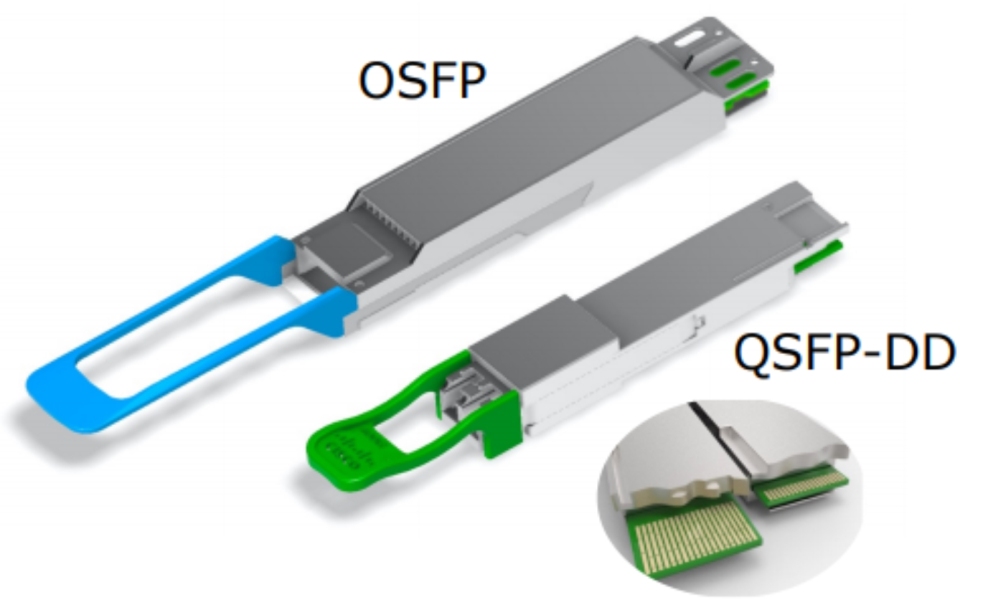Pluggable modules come in many variants, each designed for a specific purpose.
Small form factor pluggable (SPF) technology was developed to support high-speed interconnects between servers, storage, and communications equipment in data centers and similar environments. Over time, the multi-source agreement (MSA) that specifies SPF has evolved to include new formats, including SFP, SFP+, SFP28, QSPF, QSFP+, QSFP28, QSFP-DD, QSFP56, and the new octal SFP (OSFP) and QSFP-112.
This FAQ presents an overview of the various SPF form factors along with some performance comparisons. It closes with a brief look at the OSFP system.
As noted above, SPF is specified by an MSA, but it’s not an official standard. That can create some challenges. The physical form factors are well established. Because SFP is not a formal standard, some makers of SFP devices add a check function in the firmware of their modules that supports only the vendor’s own modules as a protection against substandard performance. That has resulted in other SFP makers adding EEPROMs to their modules that can be programmed to match various maker ICs. While there are eight SFP form factors, there are five that are the most common, as shown in Figure 1.

Figure 1. Common SPF form factors, SPF28 is an enhanced version of SPF+ in the same mechanical configuration.
How do they compare?
SFP and SFP+: SFP is for 100BASE or 1000BASE applications while SFP+ is used in 10GBASE applications. SFP+ ports can accept SFP optics but at a reduced speed of 1 Gb/s, but an SFP+ transceiver cannot be plugged into an SFP port.
SFP+ and SFP28: SFP28 is designed for use with 25GBASE connections. SFP+ and SFP28 have the same form factor, and compatible pinouts. SFP28 transceivers will work with SFP+ optics but at a reduced speed of 10 Gb/s.
QSFP and QSFP+: QSFP carries 4 x 1 Gb/s channels. QSFP+ supports 4 x 10 Gb/s channels and the channels can be combined into a single 409 Gb/s connection. A single QSFP+ can replace 4 SFP+ transceivers resulting in greater port density.
QSFP-DD, QSFP28, and QSFP56: QSFP-DD transceivers have the physical dimensions and same port densities as the QSFP, QSFP28, and QSFP56 but double the number of lanes to eight. QSFP-DD modules are available that support 400 Gb/s and 800 Gb/s. To accommodate the greater number of lanes, the mechanical interface of QSFP-DD on the host board is slightly deeper than that of the other QSFP transceivers to support an additional row of contacts.
What’s OSFP?
OSFP has 8 lanes in two different configurations, 50 Gb/s per lane for a total of 400 Gb/s and 100 Gb/s per lane for a total of 800 Gb/s. It’s larger than QSFP-DD and measures 22.58 x 107.8 x and 13.0 mm compared with 18.35 x 89.4 x 8.5 mm for QSFP-DD. A 1U front panel can accommodate up to 36 OSFP ports for a total of 14.4Tb/s. There are currently three single-mode fiber implementations that can support distances up to 2 km and three multi-mode fiber implementations that support distances up to 10 km. Since QSFP-DD modules are smaller their thermal capacity is only 7 to 12 watts. The larger OSFP transceivers have a thermal capacity of 12 W to 15 W (Figure 2).

Figure 2. OSFP uses a larger module with more thermal capacity compared with QSFP-DD. (Image: Fiber Mall)
Summary
There’s a wide range of SFP form factors that support an equally wide range of speeds and applications. SFP is not an official standard, it’s supported by an MSA that can result in some differences between modules from various vendors. In addition, while it’s mostly associated with optical transport, copper is also an option in some installations.
References
QSFP-DD vs OSFP vs QSFP56 vs QSFP, Fiber Mall
Quickview about SFP, SFP+, SFP28, QSFP+, QSFP28, QSFP-DD and OSFP, LightOptics
SFP vs SFP+ vs SFP28 vs QSFP+ vs QSFP28, What Are the Differences?, FS
Related articles
SFP, SFP-DD, QSFP, QSFP-DD & OSFP Pluggable interconnects – a 2021 update
How the digital-interface standards for cables and connectors are changing
How accelerator IO interface connectors and cables offer more options
New developments in 212+G per-lane data-center connectors and cables
Will internal IO copper cables for data centers become standardized?




Tell Us What You Think!